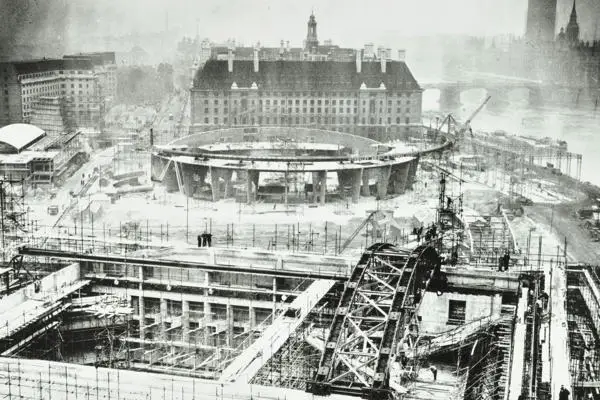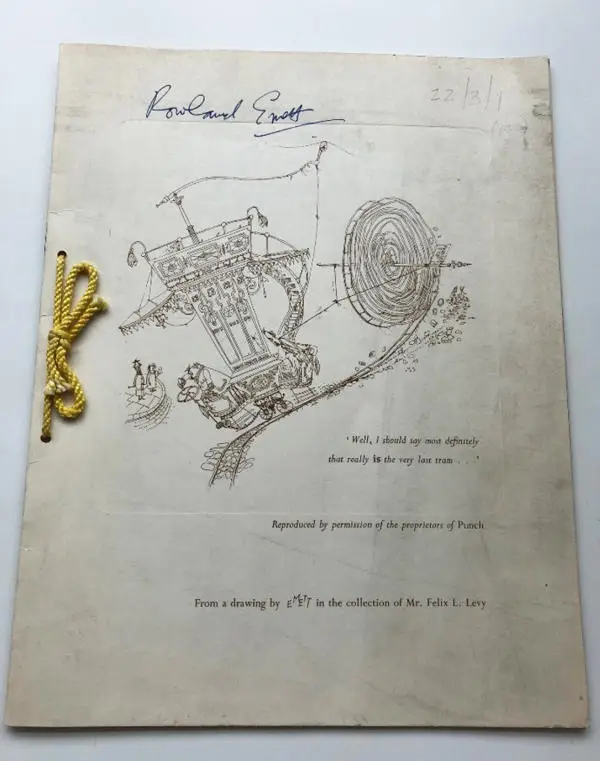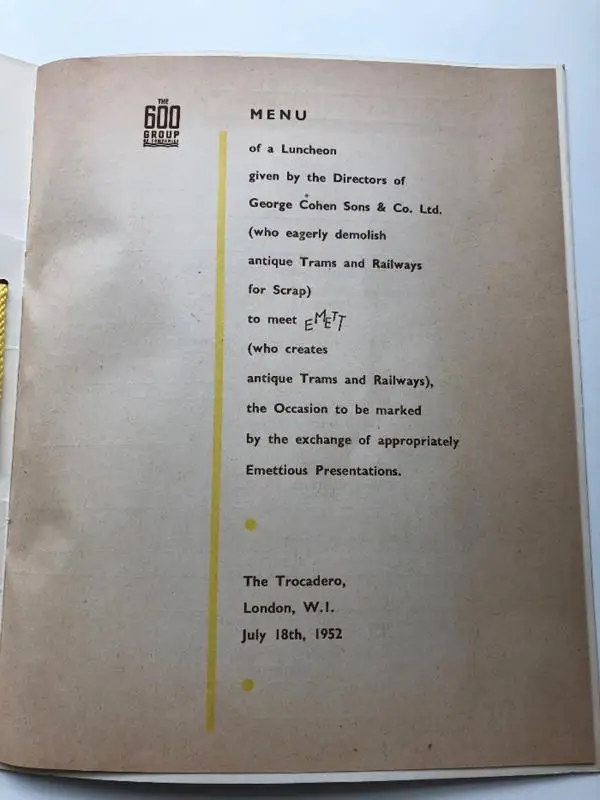Rowland Emett and the Festival of Britain 1951
2021 marks the 70th Anniversary of the Festival of Britain in 1951 which ran from May that year, with the continuing legacy of the South Bank arts centre. Herbert Morrison, a member of the London County Council and a Labour politician, was instrumental in getting things moving on the Festival. Originally intended to be a centenary celebration of the Great Exhibition of 1851, this time it looked more directly at Britain's achievements rather than the international stage, to promote British science, technology, industrial design, architecture and the arts following a need for recovery after a period of post-war austerity. Charlotte Hopkins focusses on the whimsical and ingenious contribution of cartoonist and inventor Rowland Emett whose inventiveness around railways, trains and trams is reflected in the collections at London Metropolitan Archives.
The South Bank
Later to become known as the South Bank, the main site of the exhibition was situated on the Lambeth side of the Thames, with pavilions including the Dome of Discovery, the Skylon, the Royal Festival Hall and features such as ornamental fountains. There were other sites around the country and in London Battersea Park was the site of pleasure gardens akin to those that had traditionally been at Vauxhall with a tree walk, fountains and a grotto.

As part of the Festival of Britain, Rowland Emett constructed the Far Tottering and Oyster Creek Railway which ran through Battersea Park Pleasure Gardens. The design for this is captured within programmes of the period which are in the Festival Gardens Limited (FGL) collection at LMA.
Rowland Emett and the Oyster Creek Railway at Battersea Park
Rowland Emett (1906-1990) was a cartoonist and inventor from New Southgate in London. He had drawn for the satirical periodical Punch and designed the contraptions (and famously the car) for the 1968 film Chitty Chitty Bang Bang.
Emett's final work of kinetic sculpture from 1984, A Quiet Afternoon in the Cloud Cuckoo Valley, was auctioned at Bonham's in 2019. It depicts a trip on the Far Tottering and Oyster Creek Railway, reflecting the theme of the Battersea Park pleasure railway. This contraption was exhibited at Spitalfields Market in 1992.
The Battersea Park railway was a great success during the Festival taking a thousand passengers an hour and over 2 million people around the park in total.
"All aboard for Oyster Creek"
Neptune, Wild Goose and Nellie were the locomotives used on the railway and the Guide to the Festival Gardens (FGL/025) provides descriptions along-side some of Emett's drawings:
'As for the sights on the line, look out above all for Mrs Bristow's Folly, an inspiring structure complete with water tower (Emett's hip bath came in handy here) at the entrance to the tunnel…And so, by way of Loambarrow Bottom, Cloud Cuckoo Halt (no stop) and Smugglers Reach you rattle on to Oyster Creek and all the fun of the fair.'
Neptune pulled a train of eight coaches with twelve passengers in each. The booklet goes on to describe in detail the layout in the Park:
'Behind a half circle of raised flower boxes twelve rounded pavilions, roofed like royal medieval tents, open backward into the restaurant and look forward on to a 'floating garden'.
A cocktail bar in the centre of The Crescent divides the rest of it into two main cafeterias, occupying the whole of each arm…
A few more steps, and here we are back at the Fountain Lake…Two wide pairs of steps descend here between flower boxes to water level. Beside each flight, a tall, pink obelisk billows clouds.
All this brilliance provides the foreground to a firework stage, where pyrotechnic firework fantasies and marvels performed the Giant Fern House…
From here it is a short step to Far Tottering Station (21) on the F.T. and O.Line connecting with the Fun Fair.'
You can discover more about the railway and see footage of it on YouTube Battersea's Lost Railway: The History Of The Far Tottering And Oyster Creek Railway
Edward Martin Harvey Advertising Service Ltd
In 1957, a further example of Emett’s attention to detail and whimsical touch appeared in the form of a menu (LMA/4734/22/03/001) held in the family archive of Richard Harvey produced by the Edward Martin Harvey Advertising Service Ltd (Edward was Richard's grandfather). It relates to a lunch at the Trocadero (managed by J.Lyons & Co. at this time) with 'Emett' to celebrate the scrapping of London's trams.
Emett's drawing, printed on the front of the menu, represents a fanciful tram with the track rolling up behind it, and 'request stop' visible in the centre.

Interestingly, a further connection between this menu and the Festival of Britain exists. George Cohen & Sons, which was giving the luncheon (see image below), was part of the '600 Group' of demolition contractors (named after its headquarters at 600 Commercial Road, Tower Hamlets). They were responsible for clearing the Festival of Britain site and the Skylon and the Dome of Discovery were sold to them for scrap metal. The Cohen's had originally been based at Wood Lane, White City before they sold that site to the BBC.

Items inside the menu rather playfully reference: Soleplate from Oyster Creek and Demolished & Processed Potatoes from Far Tottering.
Permission to use drawings in connection with Emett has been given by the Rowland Emett Society.
You can search the Festival Gardens Limited archive and read more about the Harvey Family archive in the Collections catalogue